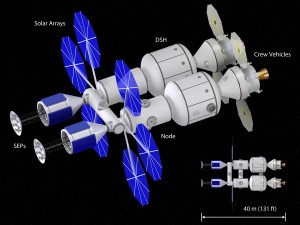Aldrin Mars Cycler
Buzz Aldrin – Popular Mechanics, December 2005.
Video taken from the game Buzz Aldrin’s Space Program Manager. ©Slitherine Ltd. 2013

In the early 1980’s, Buzz started thinking about applying his orbital rendezvous expertise to a lunar spacecraft system that would perform perpetual cycling orbits between the Earth and the Moon by using the relative gravitational forces of these two bodies to sustain the orbit, thereby expending very little fuel. The only problem was that it took longer to get to the Moon this way, and for such a short distance of a four-day trip the cycling approach was not sufficiently advantageous.
Upon the recommendation of Tom Paine (former NASA Administrator during the Apollo Moon landings), Buzz began to adapt the cycling orbit concept to the much more complex goal of human missions to Mars. Buzz’s shrewd estimations of the relative movements and positions of the Earth and Mars to determine the gravity-assist trajectories and orbital route of a perpetually cycling reusable spacecraft, as seen in his numerous hand drawings, were verified by engineers at the Jet Propulsion Laboratory (JPL). His concept worked and was christened the “Aldrin Cycler.”
Aldrin’s system of cycling spacecraft makes travel to Mars possible using far less propellant than conventional means, with an expected five and a half month journey from the Earth to Mars, and a return trip to Earth of about the same duration on a twin semi-cycler. The Aldrin Cycler’s design features a slow rotation of the spacecraft to create artificial gravity to avoid the bone and muscle loss hazard of weightlessness on long-duration trips. In each cycle when the Aldrin Cycler’s trajectory swings it by the Earth, a smaller Earth-departing interceptor spacecraft ferries crew and cargo up to dock with the Cycler spacecraft. Ultimately, the Aldrin Cycler system of transportation offers a way to make travel to Mars sustainable for the long-term, in contrast to the brief excursions to the Moon during the six Apollo lunar landings from 1969 to 1972.


More recently, Buzz has been working with engineers from Purdue University to bring to realization the schematics for the “Aldrin Mars Cycler,” as it is now referred to. In fact, James Longuski, PhD, Professor of Aeronautics and Astronautics at Purdue, with whom Buzz is working, was one of a half dozen engineers at JPL who attended Buzz’s first formal presentation on his Cycler trajectories in 1985.
Buzz envisions the first astronaut explorers the year 2030, with missions lasting 5 years or longer. Initial exploration would be followed by colonizers, permanent settlements, and eventually efforts to terraform the red planet and create a habitable Earth-like atmosphere. A five-year plus mission to Mars may seem long, but Buzz has bound at least one taker. In a 2007 interview with film director James Cameron for Wired Magazine, Buzz related to Jim the need for such an expectation on Mars missions to establish a growing permanence. Jim responded: “There won’t be any problem getting people to sign up to go to Mars for five years. Hell, I’d go.”
Resources
Images
- Aldrin Mars CyclerIllustration by Jonathan M. Mihaly (California Institute of Technology) and Victor Q. Dang (Oregon State University)
in collaboration with Buzz Aldrin, Michelle A. Rucker (NASA JSC), and Shelby Thompson (NASA JSC).
Vehicle components based on publicly available concepts for the NASA Deep Space Habitat, NASA Solar Electric and Cryogenic Propulsion modules, and the Lockheed Martin Orion vehicle
Buzz-Authored and Co-Authored Articles
- “A Bolder Mission” Popular Mechanics, Aug 2009
- “Continuous Mars Habitation with a Limited Number of Cycler Vehicles” Journal of the British Interplanetary Society, Vol. 60, Apr 2007
- “Road Map to Mars” Popular Mechanics, Dec 2005
- “Powered Earth-Mars Cycler with Three-Synodic-Period Repeat Time” Journal of Spacecraft and Rockets, Vol. 42, No. 5, Sep-Oct 2005
- “Preliminary Analysis and Design of Powered Earth-Mars Cycling Trajectories” AIAA/AAS Astrodynamics Conference Paper, 5-8 Aug 2002
- “Evolutionary Space Transportation Plan for Mars Cycling Concepts” Report for NASA/JPL, 15 Dec 2001
- “A Bus Between Planets” Scientific American, 21 Mar 2000
- “Recycling Our Space – No Deposit…No Return!” Ad Astra, Jul/Aug 1996
- “Cycler Orbit Between Earth and Mars” Journal of Spacecraft and Rockets Vol. 30, No. 3. May/Jun 1993
- “Mars Transit System” Air & Space Smithsonian, Oct-Nov 1990
- “Cyclic Trajectory Concepts” Aldrin’s SAIC presentation to the Interplanetary Rapid Transit Study Meeting, Jet Propulsion Laboratory, 28 Oct 1985.
Other Articles and Papers
- “The Martian Express” damnedinteresting.com, 10 Apr 2008
- “Strategies for Continuous Mars Habitation with a Limited Number of Cycler Vehicles”Purdue University School of Aeronautics and Astronautics, Paper Prepared for Buzz Aldrin, Oct 2005
- “Buzz Aldrin and Purdue University Engineers Plan Mars Hotels” Space Times, Mar/Apr 2002
- “Exclusive: Buzz Aldrin Blazing Trail to Mars” newsfactor.com, 19 Feb 2002
- “Buzz Aldrin Proposes Sending Astronauts to Mars via Cheap Space Bus” Knight Ridder Washington Bureau, 9 Feb 2002
- “Space Hotels Could Run Ferry Service to Mars” The Guardian, 7 Feb 2002
- “Analysis of a Broad Class of Earth-Mars Cycler Trajectories”American Institute of Aeronautics and Astronautics (AIAA) Paper, 2002
- “ Q&A with Buzz Aldrin – The Next Giant Leap: Mars?” USA Weekend, 27 Jun 1997
- “The Martian Metro” OMNI, Vol. 10 No. 2, Nov 1987




